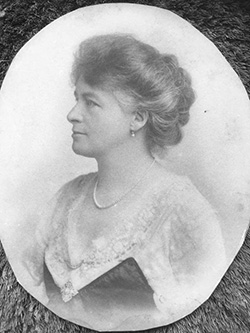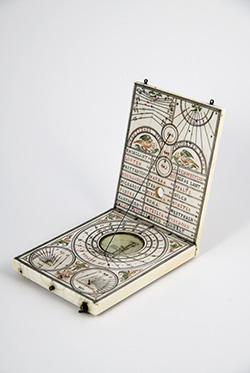Lewis EVANS JP DSc FSA FRAS 1853 - 1930
He was the second child, second son of John Evans and Harriet Ann née DICKINSON
Born 15th February 1853
Died 25th September 1930
Married:
Firstly Beryl May WARD (23 May 1866 - 19 Nov. 1886) on 14 February 1884; daughter of the Rev. Percival Seth WARD of Apsley.
Secondly Eva Fanny BRADFORD (16 June 1866 - 1928) daughter of Captain BRADFORD
Eva Fanny BRADFORD
Lewis and Eva Fanny had five children
1 Alice Dorothy (Dody) EVANS b.16 Feb.1892 d. 3 March 1979. married
(1) Major Eduard GARTMAYER (Bavarian Army) in 1913
(2) Thomas JENKINS in 1925
2 Flora Jane EVANS b. 29 May 1896 d. 29 Jan. 1981 married
Capt. Arthur Amys Fausset BAKER I.A. 1921 in Karachi.
3 Eva Mary EVANS b. 11 Oct. 1897 d. 18 Feb.1953 married
Basil MOODY in 1919
4 Anne Barbara EVANS b. 3 Jan 1899 d. 15 Sept. 1977 married
Cecil E.L. WATKINS K.O.Y.L.I. in Port Said 1930
5 John Dickinson EVANS b. 27 May 1901 d.13 April 1975 married
(1) Catherine E. HILDYARD in Dawlish 1928
(2) Barbara KINGSFORD in 1947
A biographical account
The following notes have been taken from ‘A biographical account’ by Tony Simcock; History of Science Museum
Lewis Evans (1853–1930)
Lewis Evans was born in Hemel Hempstead into a family that belonged equally to the intellectual world and the world of business. Several ancestors and kinsmen on his father’s side had been distinguished scholars, writers, or mathematical scientists; his mother was a daughter of John Dickinson, founder of a well-known paper and stationery manufacturing company.
Sir John Evans was one of those capable Victorians who seemed able to shine in both worlds. He assumed the management of John Dickinson & Co. and kept it in a flourishing state; he became an authority on water supply and hydraulic geology (on which his paper mills depended); and he chiefly achieved distinction as an archaeologist, with special knowledge of numismatics. His first two sons were educated at Harrow School, but after that their careers diverged. The eldest, groomed as the father’s intellectual successor, went on to university and a glamourous archaeological career; this was Sir Arthur Evans, famous excavator of Knossos and Keeper of the Ashmolean Museum. As the second son, Lewis was groomed as the father’s business successor, and in 1871 entered the paper-making business, eventually becoming its managing director.
If Lewis Evans regretted his exclusion from academia, the compensation was the wealth that enabled him to pursue his collecting interests. Encouraged by his father, he found an area of specialization that satisfied his mathematical talent, which he believed to be inherited from his great-grandfather and namesake, an astronomer and mathematical teacher at the beginning of the 19th century.
Lewis Evans was the ‘Sundial Man’; his greatest interest and the overriding theme of his collection was sundials. The whole range of traditional mathematical instruments was eventually represented in the Lewis Evans Collection.
Evans also collected books and prints relating to Hertfordshire, and there is a wholly different ‘Lewis Evans Collection’ of this material elsewhere. He was a Fellow of the Royal Astronomical Society and a Fellow of the Society of Antiquaries.
Obituary of Dr Lewis Evans in Nature
In the Lewis Evans Collection of Historic Scientific Instruments is a small jointed rule of ivory, inset with a compass needle, and engraved as a portable sundial. It was a special favourite of Dr. Lewis Evans, whose death occurred on Sept. 25 last, because it bears the inscription, "Registered 1853 ", which by a happy chance was the year of his birth, on Feb. 15. Twenty years later Francis Galton might well have included the Evans family among those English men of science whose hereditary influences and education he described at the Royal Institution, for at least four generations have achieved scientific distinction. The Rev. Lewis Evans, vicar of Froxfield, 1788-1827, was an accomplished mechanician and astronomer, who ground his own specula, recorded observations, and continued to 1864 the calculations on Ferguson's Astronomical Instrument and Rotula, published in 1817. He had been educated at Merton College, Oxford, was instructor in mathematics at the Royal Academy at Woolwich, and became a fellow of the Royal Society in 1823. He was in the habit of communicating mathematical notes to the Reading Mercury under the nom de plume of 'Felix Ford' (anagram of Froxfield), some of which are preserved with his lecture MSS. in the Lewis Evans collection. One of his sons, Thomas Simpson Evans, LL.D., became an assistant at Greenwich and, later, mathematical instructor at Woolwich. His grandson, Sir John Evans, K.C.B., for many years treasurer of the Royal Society, attained to special eminence as an antiquary, a branch of study which has been materially extended by both his sons-Arthur, who has also the scientific blue-ribbon of F.R.S., and Lewis, the subject of this notice, who died on Sept. 25. On the distaff side, two ancestors had also achieved similar distinction, namely, John Dickinson, F.R.S., F.S.A., and George Dionysius Ehret, F.R.S., the inimitable flower painter, who was born at Erfurt in 1708, and died at Chelsea in 1770.
Owing to the great demands made upon his time and energy by the needs of a great manufacturing business, Lewis Evans was more than forty years of age before he published his first paper, "On Pocket Sundials", a modest article illustrated by neatly executed cuts of the author's own drawing. This was followed by a fuller contribution upon the same subject to Mrs. Alfred Gatty's standard " Book of Sundials ", 1900. His knowledge was largely based upon his own rapidly expanding collection of scientific instruments, in which a perfect Roman portable dial of about A.D. 300 was then one of the greatest treasures. In 1901 there appeared in Archceologia the account of another of his discoveries-the original dial of gilt brass made for Cardinal Wolsey by Nicholas Kratzer, who at the time was" reading Astronomy in the University by the command of King Henry VIII and soon after made by Cardinal Wolsey his Mathematical Reader when he first settled his lecture there ". Kratzer was made a fellow of Corpus by Richard Fox in A.D. 1517.
From this time on, many writers at home and abroad drew upon the experience of Dr. Evans, notably Dr. Joseph Drecker of Dorsten, and with the dispersal of other collections his own collection grew. It was many years before he could obtain an astrolabe, but " nothing succeeds like success ", and the first he acquired was soon followed by some three score others, the most important of which he figured and described in " Some European and Oriental Astrolabes", in the Archaeological Journal in 1911. In 1922 he offered the whole of his unique collection of dials and early scientific books and instruments to the University of Oxford. It is by far the most important collection of the kind that has ever been given to a university; and owing to peculiar circumstances, the present gift is a lasting memorial to the noble-minded generosity of the donor-for, like the Mensing collection, it might quite easily have been sold for a fortune to America, and thus have been lost to Europe. Incidentally it has served as a nucleu1;1 around which other benefactors, including many Oxford colleges, have deposited instruments and objects of value for illustrating the progress of scientific studies and research in the University. In the past five years the space needed for the proper exhibition of the collection has doubled in area, and apparatus of the very greatest importance has had to be refused, on the ground that the best exhibition space available in the Old Ashmolean Building is still being occupied by the staff and books of the English Dictionary, although that work was completed many months ago.
As was recently pointed out in NATURE in a letter signed by the president of the Institute of Physics and others, scientific instruments, often the landmarks of invention, are lost so long as they are hidden and not in the charge of someone who appreciates their scientific value. No one realised this more vividly than did Dr. Lewis Evans himself. Although an ardent admirer of art and craftsmanship, he felt that to place unique instruments of science among art objects in a gallery of. art, as is the case in the British Museum and at South Kensington in London, or at the Ashmolean Museum in Oxford, or to group scientific apparatus among books and to catalogue it as ' manuscripts ', as is now the practice in the Bodleian Library, is both derogatory to science and destructive to the proper study of its history. He therefore determined that his collection should either 'go to the hammer', or else be shown as a scientific collection with all the advantages of exhibition that art collections usually enjoy. By the greatest good fortune, a part of the most historic building connected with the early history of science in Britain, the Old Ashmolean, was available, and this being approved by Dr. Evans, was allocated by the University to his collection. The Goldsmiths' Company voted £1000 for initial expenses, and is now offering £500 more if and when a greatly needed extension of exhibition space is forthcoming either in the Old Chemical Laboratory or in the original meeting-room of the Oxford Scientific Society of 1683. A benefactor to complete the good work which Dr. Lewis Evans has so generously begun is urgently needed, for the losses of most important instruments are great and are continuing. R. T. G.


